Discover 8 hidden attractions, cool sights, and unusual things to do in Bighorn Canyon National Recreation Area (United States). Don't miss out on these must-see attractions: Yellowtail Dam, Bighorn Lake, and Caroline Lockhart Ranch. Also, be sure to include Ewing-Snell Ranch in your itinerary.
Below, you can find the list of the most amazing places you should visit in Bighorn Canyon National Recreation Area (Montana).
Table of Contents
Yellowtail Dam
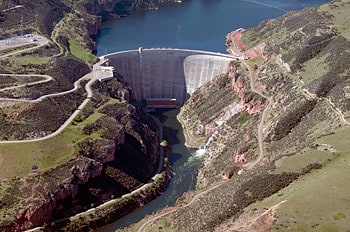
Dam in Montana. Yellowtail Dam is a dam across the Bighorn River in south central Montana in the United States. The mid-1960s era concrete arch dam serves to regulate the flow of the Bighorn for irrigation purposes and to generate hydroelectric power. The dam and its reservoir, Bighorn Lake, are owned by the U.S. Bureau of Reclamation.
The project was the result of negotiations between the federal government and the Crow Nation, the tribe of Native Americans that lived on the surrounding Crow Indian Reservation, and was originally envisioned as a shared facility that would provide profits for both sides. Eventually, the land was sold to Reclamation, although much of the reservoir, which extends 72 miles (116 km) upstream into Wyoming, lies in the reservation. The dam was authorized in 1944 and groundbreaking was in 1961; it was completed in 1967 after six years of construction. Today aside from its original purposes the dam serves for recreation both above and below the structure. Regulation of the Bighorn provided by the Yellowtail Dam has transformed the lower river into one of Montana's premier trout streams. However, there has been significant controversy surrounding the allocation of water in the reservoir between Montana and Wyoming, and the ecological damage wrought on 184 miles (296 km) of river both above and below the dam.[1]
Bighorn Lake

Reservoir in the United States of America. Bighorn Lake is a reservoir behind Yellowtail Dam within the Bighorn Canyon National Recreation Area, located in northern Wyoming and extending into southern Montana.[2]
Caroline Lockhart Ranch
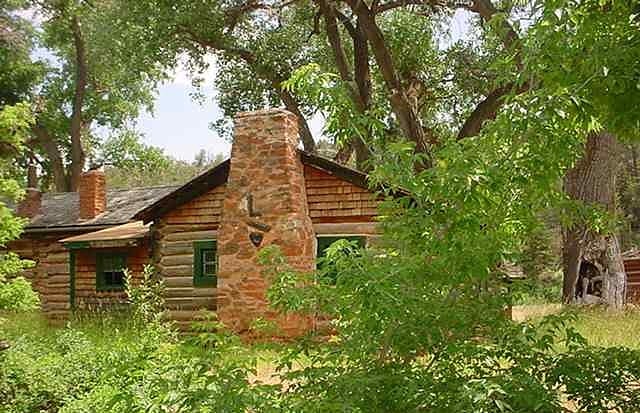
The Caroline Lockhart Ranch was established in 1926 by Caroline Lockhart, who purchased a 160-acre homestead near Davis Creek at the foot of the Pryor Mountains in Carbon County, Montana, while in her fifties. Lockhart expanded the ranch, adding buildings, land and grazing rights until the ranch comprised about 7,000 acres. The region, known as Dryhead Country, is one of the most isolated places in Montana.
Caroline Cameron Lockhart was a writer in Philadelphia, who worked as a reporter in Philadelphia and Boston, specializing in investigative reporting. Born in Illinois in 1871, she had grown up on a ranch in Kansas. Lockhart moved to Cody, Wyoming in 1904, writing novels, screenplays and working for the Denver Post. She bought the Cody newspaper, the Park County Enterprise, renaming it the Cody Enterprise in 1921, and selling it in 1925. In 1926 she bought the ranch, living at the L/♥ in the summers and in Cody in the winter. She moved back to Cody in 1950 as her health declined, selling the ranch.
The Tippetts family bought the ranch from Lockhart in 1955, primarily for the land rights. The structures were left to deteriorate. In 1980 the property was acquired by the National Park Service and incorporated into Bighorn Canyon National Recreation Area. The structures have been restored by the Park Service as nearly unique examples of local ranching culture and vernacular construction.[3]
Ewing-Snell Ranch
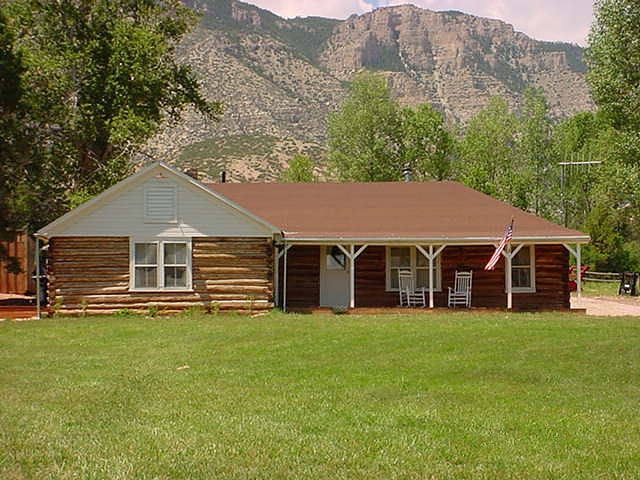
Historical landmark in Carbon County, Montana. The Ewing-Snell Ranch was established between 1896 and 1898 by Erastus Ewing in Carbon County, Montana, on Layout Creek between Bighorn Canyon and the Pryor Mountains in a region called Dryhead Country. Ewing took up ranching after failing as a gold miner.
Erastus Ewing was born in Tennessee about 1846, arriving in Montana in the 1880s to look for gold. He staked numerous claims, one of which controlled the water rights for Layout Creek. After giving up prospecting, he used the rights to establish his ranch, digging a ditch to his homestead from the creek.
Ewing's place was designated a post office in 1898, operating until 1906 as Ewing, Montana before moving to the Caroline Lockhart Ranch. Erastus died in 1904. His son Lee sold the ranch to Clint Hough in 1911, who sold it to Philip Snell in 1918. The shop building operated as the Dryhead School in 1945–57. Snell's descendants sold the ranch to Newell K. Sorenson in 1964. Sorenson sold 640 acres (260 ha) to the Bureau of Reclamation for the construction of Yellowtail Dam in 1968. The ranch is part of Bighorn Canyon National Recreation Area.
The Ewing-Snell Ranch was placed on the National Register of Historic Places on May 12, 1977.[4]
Bad Pass Trail
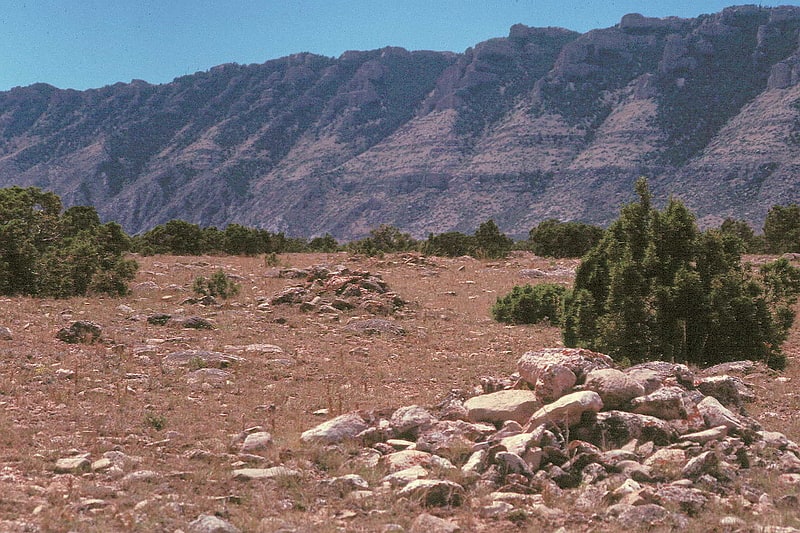
The Bad Pass Trail, also known as the Sioux Trail, was established by Native Americans on the border of present-day Montana and Wyoming as a means of access from the Bighorn Basin in Wyoming to Bison-hunting grounds in the Grapevine Creek area of Montana. Marked by stone cairns, the trail led across Bad Pass and was established in pre-Columbian times. After Europeans arrived in the area it was frequented by fur trappers and mountain men, beginning in 1824. Trappers assembled pack trains at the junction of the Shoshone River and the Bighorn River, using the Bad Pass Trail to avoid Bighorn Canyon. The trail ended at the mouth of Grapevine Creek on the Bighorn, from which the pack train could float down the Bighorn on rafts to the Yellowstone River and then to the Missouri and on to St. Louis.
Approximately three hundred cairns are known to exist along the trail, particularly in Bighorn Canyon National Recreation Area. The cairns are believed to have been built incrementally, with passer-by placing stones on the pile as a good luck offering. Much of the trail itself has been altered beyond recognition by the construction of an access road for area ranches. The trail runs along the western side of Bighorn Canyon. It is estimated to have been in use for ten to twelve thousand years. The trail features as many as one thousand tipi rings on either side of the trail, some of which have been evaluated by archeologists.
The Bad Pass Trail was placed on the National Register of Historic Places on October 29, 1975.[5]
Bighorn Ditch Headgate

The Bighorn Ditch Headgate, also known as the Bighorn Canal Headgate, was built starting in 1892 to provide irrigation to the Crow Indian Reservation in south central Montana. The headgate structure diverted water from the Bighorn River to their lands. It was designed by William F. Graves, and construction was carried out by Crow workers. The project was completed in 1904. Today the site is included in Bighorn Canyon National Recreation Area.
The structure includes a diversion dam extending at an angle into the river to divert water through the headgate into a canal flowing parallel to the river. The headgate structure was built of dressed local limestone, and is 35 feet (11 m) wide, allowing a designed flow of 720 cubic feet (20,000 L) of water per second. Five iron gates controlled the flow. The headgate structure is intermittently inundated by water held in the Yellowtail Dam Afterbay reservoir.
The Bighorn Ditch was instrumental to the Crow changing from their nomadic lifestyle to a settled, agrarian society. Their initial attempts at farming in the arid climate, beginning in 1885, resulted in failure. The government at last recognized that irrigation of the lands would be required for the people to gain consistent yields from their crops. The 1891 Reno Ditch provided water to 4500 (later 12,500) Crow acres. The Bighorn Ditch allowed the expansion of agriculture and cattle ranching to 35,000 acres (140 km2). As a result, the Crow no longer needed Federal food subsidies.
The Bighorn Ditch headgate was placed on the National Register of Historic Places on December 12, 1976.[6]
Cedarvale
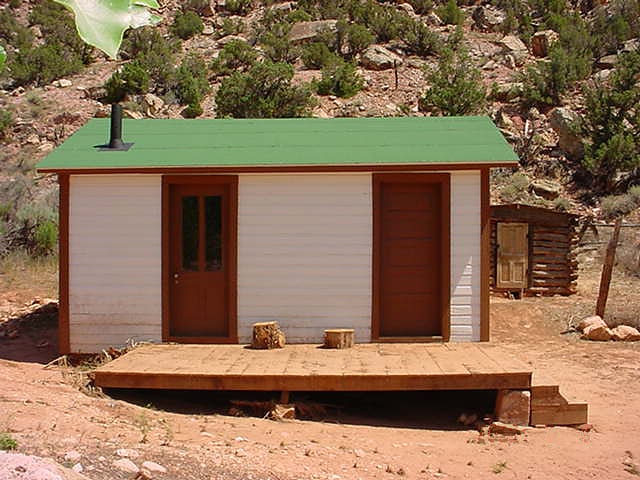
Cedarvale, also known as Hillsboro Ranch, was a dude ranch and working ranch in Carbon County, southern Montana, United States. The ranch was established about 1903 by prospector Grosvener W. Barry on the South Fork Trail Creek. Barry used the ranch as a home for his family and as a base for his mining ventures, all of which failed. His most lucrative venture was the conversion of Cedarvale from a working ranch to a dude ranch, marketed through an arrangement with the Chicago, Burlington and Quincy Railroad. It was the first dude ranch in the area. Barry introduced powered boats to the Bighorn River to carry dudes to the ranch from the railhead at Kane, Wyoming. As a publicity stunt Barry, his stepson and a neighbor piloted the 16-foot motorized Edith from the Hillsboro landing down the Bighorn, Yellowstone, Missouri and Mississippi rivers, leaving on May 31, 1913 and arriving in New Orleans on August 1. One of Barry's boats, the Hillmont, is on display at Barry's Landing.[7]
M L Ranch
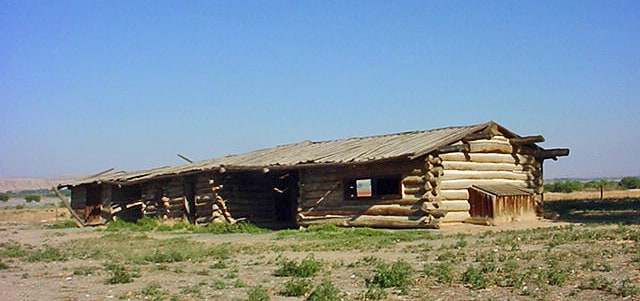
The M L Ranch was established by Henry Clay Lovell and his financial backer Anthony Mason in Wyoming's Big Horn Basin in the late 1870s to the south of the present location. The second and final location was established farther north as a cattle line camp in 1883 to be closer to markets in Billings, Montana. In 1884 it became the headquarters for a ranch that reached 25,000 acres in area. The bad winter of 1886–87 killed half the livestock on the ranch, more than 10,000 head. but the M L fared better than most. Mason died in 1892. Lovell died in Oregon in 1903. Lovell, Wyoming was named in his memory. The Lovell family ran the ranch until 1909. In the early 1960s the ranch was purchased by the Bureau of Reclamation as part of the Bighorn Lake reservoir project. In 1966 the headquarters site was transferred to the National Park Service as part of Bighorn Canyon National Recreation Area.
The M L Ranch was listed on the National Register of Historic Places on July 15, 1992.[8]